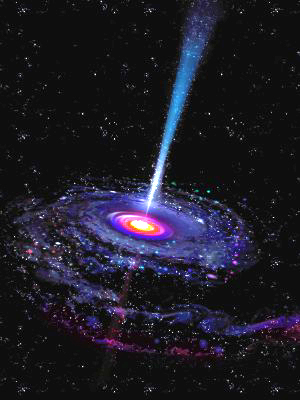Black hole

The theory of black holes was conceived by Karl Schwarzschild during World War II. [1] The term black hole for the then-theoretical celestial object was coined later by John Wheeler. [2] Black holes are thought to have the escape velocity faster than the speed of light, which means not even light can escape their gravitational fields. Currently, most astronomical scientists have reached the consensus that black holes exist at the center of every galaxy.
Physical Properties
Black holes can only be described by their spin, charge, and angular momentum, with other attributes derived from the basic properties. They are thought in classical cosmology, i.e. the Big Bang model, to be the result of collapsing matter following the explosion of large stars into supernovae. Therefore, the mass of a black hole is often depicted in terms of solar mass, denoted as m⊙.ּּ
With their basic physical properties, four types of black holes have been proposed by theoretical physicists, with each type named in honor of them: [3]
| Name | Charge | Spin |
|---|---|---|
| Schwarzchild black hole | No | No |
| Kerr black hole | No | Yes |
| Kerr-Newman black hole | Yes | Yes |
| Reissner-Nordström black hole | Yes | No |
The Big Bang Interpretations
The idea of the universe starting out from an atom originated from the Belgian physicist contemporary to Einstein's time, George Lemaître. On March 28, 1949, the English astronomer Fred Hoyle popularized the phrase the "Big Bang" during a defense. [4] The framework of the Big Bang Theory and nuclear physics was later constructed into the cosmic interpretations of the theoretical celestial object.
Two types of black holes are categorized in the Bang Bang model, primordial black hole and the normative black hole. Primordial black holes are thought to be created not soon after the Big Bang, and the normative black holes are thought to be created after a star exhausted its capacities for nuclear fusion. It is estimated that for a star to be capable of compaction into a singularity, it must have a mass greater than 3.4 times that of the Sun.
Characteristics
There are both rotating and stationary black holes, a singularity and event horizon(s) being the major features of both. The event horizon is the boundary of a black hole where gravitational forces become so strong that not even light can escape. Relativity states that the singularity is a point of infinite space time curvature, and the singularity of a black hole is covered by the event horizon. To an outside observer, objects falling into a black hole will take an infinite amount of time to reach the event horizon. However, the amount of time as measured by the object falling into the black hole can be very short. A rotating black hole, according to the Kerr solutions of general relativity, will have two event horizons, and there are spacetime paths through the event horizon which do not intersect the singularity.
According to quantum mechanics, the location of the matter within a black hole is uncertain. Additionally, a phenomenon called Hawking radiation predicts that black holes can "leak" a very small amount of mass. So theoretically, black holes are not truly "black" due to emitted radiation. Black holes have a surface temperature defined by their mass. The larger the mass of a black hole, the larger the diameter, and the lower the amount of energy which escapes, thus the lower the temperature, and the longer the time it takes for the black hole to "evaporate".
Detection and Observation of Black Holes
Methods of detecting and observing black holes include imaging using radio telescopes and also gravitational wave detection.
In 2015, the two LIGO (Laser Interferometer Gravitational-Wave Observatory) detectors in the USA made the first-ever detection of gravitational waves, which were emitted by two colliding black holes that were approximately 29 and 36 times as massive as the Sun. Since then, the Virgo detector in Italy has also contributed to gravitational wave detection.
In 2019, a direct image of a black hole was made using the Event Horizon Telescope, which is actually a worldwide network of radio telescopes. This black hole is 6.5 billion times more massive than the Sun and located 55 million light-years away in the galaxy M87.
- ↑ Schnittman, J. (2019). A brief history of black holes, Astronomy magazine.
- ↑ Overbye, D. (2008). John A. Wheeler, Physicist Who Coined the Term ‘Black Hole,’ Is Dead at 96, New York Times.
- ↑ Pachankis, Y. I. (2022). Neutron Number Asymmetry in Proton Decay Momentum, Journal of Agricultural, Earth & Environmental Sciences, 1(1): 1-9. Bibcode: 2022JAEES...1....1P
- ↑ Wood, C. (2019). The Big Bang Theory: How the Universe Began, Live Science.